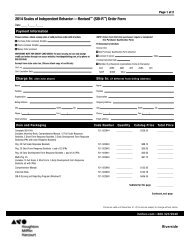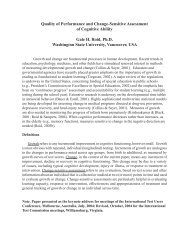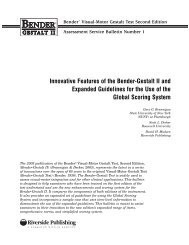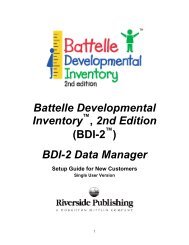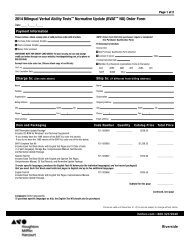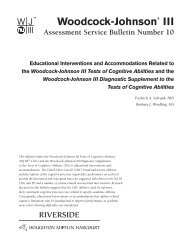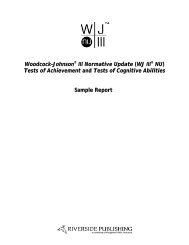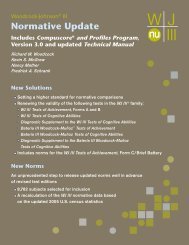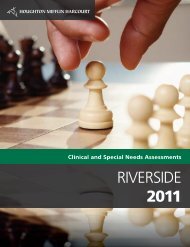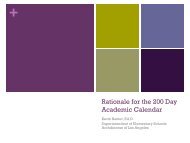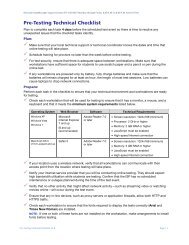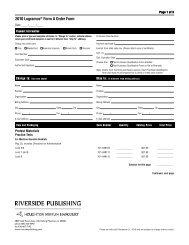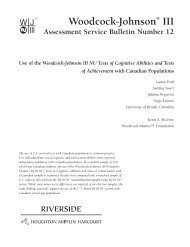Collaboration Lite Puts Student Achievement on a Starvation Diet
Collaboration Lite Puts Student Achievement on a Starvation Diet
Collaboration Lite Puts Student Achievement on a Starvation Diet
- No tags were found...
You also want an ePaper? Increase the reach of your titles
YUMPU automatically turns print PDFs into web optimized ePapers that Google loves.
Standards• <str<strong>on</strong>g>Student</str<strong>on</strong>g>s will estimate the sociologicalproblems which might be associated with theend of the world, and c<strong>on</strong>struct an experimentto test their theory.
Back mapping• Traditi<strong>on</strong>al standards started with kindergarten andthen added years of work <strong>on</strong> top of those (and havefocused heavily <strong>on</strong> existing curricula and noti<strong>on</strong>s ofdevelopment)• The comm<strong>on</strong> standards began with college and careerreadiness standards and then back mapped from there• This means that the standards demand growth aimedat ensuring students reach graduati<strong>on</strong> targets (ratherthan depending so heavily <strong>on</strong> what we have d<strong>on</strong>e inthe past)• This makes these standards more challenging thanpast standards
Comm<strong>on</strong> Core Standards architect David Coleman ……• “Teachers must train students to be workers in theGlobal Ec<strong>on</strong>omy. It is rare in a working envir<strong>on</strong>mentthat some<strong>on</strong>e says, “Johns<strong>on</strong>, I need a market analysisby Friday but before that I need a compelling accountof your childhood.”• Translati<strong>on</strong> to the classroom: No more primary gradeessays about lost teeth or middle school essays aboutprepubescent angst. Instead, students must providecritical analysis of the “Allegory of the Cave” fromPlato’s Republic, listed as an “exemplary informati<strong>on</strong>altext” in the Comm<strong>on</strong> Core State Standards
“Goodnight”- Goodnight Mo<strong>on</strong>
The Typical Classroom for 2012-2013• 11 of the 30 students will live in poverty• 10 of the students will be n<strong>on</strong>-White• 12 of the student’s primary language will not be English(<strong>on</strong>e of 150 languages spoken in the US)• 6 will not be reared by their biological parents• 1 will be homeless• 6 will move at least 4 times before grade 7U.S. Department of Educati<strong>on</strong> Census Bureau
And let’s notforget theEc<strong>on</strong>omicTsunami many ofour families arestill trying torecover from.Source:
Value AddedThis student’s 2004 scorewas higher than predictedThis student’s 2004 scorewas lower than predicted
Good schools get all this. Thegrown ups who work in theseschools are not asked to beindependent c<strong>on</strong>tractors-martyrs orgeniuses
But We All Collaborate……Professi<strong>on</strong>al LearningCommunities, Child Study Groups, Data Teams,Classroom Planning Time, Bob
Source:
Lost in Translati<strong>on</strong>……………..• “Collaborate”• “Watch the Kids”• “Clean your room”21
Agree/Str<strong>on</strong>gly Agree
Agree/Str<strong>on</strong>gly Agree
Agree/Str<strong>on</strong>gly Agree
Agree/Str<strong>on</strong>gly Agree
Agree/Str<strong>on</strong>gly Agree
Data Teams Implementati<strong>on</strong> Survey Results TableWe Haven’tD<strong>on</strong>e This YetWe Are Working<strong>on</strong> This StepStepPLANForm Data Teams and schedulemeetings 35% 25% 40%Assign Data Team Roles:Leaders, Recorder… 80% 15% 5%Schedule Data Team leader andadministrator meetings 60% 30% 10%We analyze our data to uncoverour Success Stories and H<strong>on</strong>estBad News. 35% 45% 20%DOWe develop m<strong>on</strong>thly CurriculumCalendars and make thecommitment to teach someindicators at the same time - thebad news indicators and the l<strong>on</strong>gand lingering indicators 45% 30% 25%We develop and administerComm<strong>on</strong> Pre-Assessments 50% 30% 20%We analyze Pre-Assessment data,develop a comm<strong>on</strong> less<strong>on</strong> andset our teaching goal 45% 50% 5%We develop and administerComm<strong>on</strong> Post-Assessments 15% 20% 65%We meet to determine if our goalwas met; provide interventi<strong>on</strong>(s)for students who did not masterat proficient level and discusshow we will adjust this less<strong>on</strong> forthe next year. 30% 60% 10%CHECKCreate formalized system forposting Data Team charts andgraphs 70% 25% 5%Create internal evaluati<strong>on</strong> andcommunicati<strong>on</strong> system 70% 25% 5%Create external evaluati<strong>on</strong> andcommunicati<strong>on</strong> system 85% 10% 5%We are ReallyDoing This
Collective Intelligence(men—put your cell ph<strong>on</strong>es down)• How big is the mo<strong>on</strong>?The mo<strong>on</strong> is about _______miles across.• How far is it from Earth to the mo<strong>on</strong>?It is about _________ miles from Earth to themo<strong>on</strong>.• How old is the mo<strong>on</strong>?The mo<strong>on</strong> is the same age as the Earth andthe rest of the solar system — about ____billi<strong>on</strong>years. Our solar system was all formed at thattime.
Collective Intelligence• How big is the mo<strong>on</strong>?The mo<strong>on</strong> is about 2,000 miles across.• How far is it from Earth to the mo<strong>on</strong>?It is about 250,000 miles from Earth to the mo<strong>on</strong>.• How old is the mo<strong>on</strong>?The mo<strong>on</strong> is the same age as the Earth and the rest ofthe solar system — about 4.5 billi<strong>on</strong> years. Our solarsystem was all formed at that time.
Source:•
A System• The first key term in this definiti<strong>on</strong> is SYSTEM. Teachers arenot invited or encouraged to collaborate. <str<strong>on</strong>g>Collaborati<strong>on</strong></str<strong>on</strong>g> isembedded in the routine practices of the school.• Teachers are organized into teams and provided time to meetduring the school day. They are provided specific guidelines andrequired to engage in specific activities that help them focus <strong>on</strong>student achievement.• The team agenda is all about two questi<strong>on</strong>s:What are the priority skills for this quarter?How can we be more effective teaching these priorities?Source:31
• The SYSTEM ensures the entire staff workstogether to focus c<strong>on</strong>stantly <strong>on</strong> those priorityskills.• Not Book Clubs• Not Prom Rules• Not Prezi• <strong>Diet</strong> Cards• 3 legged dogs• Walk ThroughsSource:
Matter over Chatter• Sec<strong>on</strong>d, the SYSTEM is designed to impactprofessi<strong>on</strong>al practice. Teachers do more thananalyze, reflect, discuss, or debate. They usecollaborati<strong>on</strong> as a catalyst to change their practices.• How they teach the less<strong>on</strong> <strong>on</strong> weather or fracti<strong>on</strong>s Changes(for the better)!Source:
Keep Score—Politicians and Parentsare!• Third, the effectiveness of the SYSTEM is assessed<strong>on</strong> results rather than percepti<strong>on</strong>s, projects, orpositive intenti<strong>on</strong>s.• Teams identify and pursue specific, measurable,student outcomes. <str<strong>on</strong>g>Student</str<strong>on</strong>g> performance is thebarometer of success.• “85% of my class will reach the proficient level <strong>on</strong> ourObservati<strong>on</strong> vs. Inference less<strong>on</strong>”.Source:
A Good Systemensures that, “teachersare nosy, noisy andtravel in packs”My Grandma, 1997
Horiz<strong>on</strong>tal Design/Data TeamElementaryGrade 3 TeacherGrade 3 TeacherGrade 3 TeacherSee page 63
Vertical Design/Data TeamMiddle School Department Team/Small School TeamGrade 6(K) Math TeachersGrade 7(1) Math TeachersSee page 63Grade 8 (2)Math Teachers
Balanced Assessment Model6. Analyze Post-Assessmentdata.• Plan interventi<strong>on</strong>s forstudents who did not masterthe standard.• Plan how you will tweak yourless<strong>on</strong> for next year.5. Develop and AdministerComm<strong>on</strong> Post-Assessment• Feedback for administrators,teachers and students• Prove Learning1. Develop or Revise M<strong>on</strong>thlyCurriculum Calendars• Commit to teach the bad newsstandards and the l<strong>on</strong>g andlingering standards at thesame time• Develop a timelineWhen your summativedata comes back, uncoveryour success storiesand h<strong>on</strong>est bad news.4. Teach Teach Teach Teach2. Develop and AdministerComm<strong>on</strong> Pre-Assessments• Find out what your studentsknow, d<strong>on</strong>’t know and want toknow3. Analyze Pre-Assessment data• Identify student barriersstrengths and interests• Develop Instructi<strong>on</strong>alStrategies and Less<strong>on</strong>• Use data to improveinstructi<strong>on</strong>38
Balanced Assessment Model6. Analyze Post-Assessmentdata.• Plan interventi<strong>on</strong>s forstudents who did not masterthe standard.• Plan how you will tweak yourless<strong>on</strong> for next year.5. Develop and AdministerComm<strong>on</strong> Post-Assessment• Feedback for administrators,teachers and students• Prove Learning1. Develop or Revise M<strong>on</strong>thlyCurriculum Calendars• Commit to teach the bad newsstandards and the l<strong>on</strong>g andlingering standards at thesame time• Develop a timelineWhen your summativedata comes back, uncoveryour success storiesand h<strong>on</strong>est bad news.4. Teach Teach Teach Teach2. Develop and AdministerComm<strong>on</strong> Pre-Assessments• Find out what your studentsknow, d<strong>on</strong>’t know and want toknow3. Analyze Pre-Assessment data• Identify student barriersstrengths and interests• Develop Instructi<strong>on</strong>alStrategies and Less<strong>on</strong>• Use data to improveinstructi<strong>on</strong>39
Balanced Assessment Model6. Analyze Post-Assessmentdata.• Plan interventi<strong>on</strong>s forstudents who did not masterthe standard.• Plan how you will tweak yourless<strong>on</strong> for next year.5. Develop and AdministerComm<strong>on</strong> Post-Assessment• Feedback for administrators,teachers and students• Prove Learning1. Develop or Revise M<strong>on</strong>thlyCurriculum Calendars• Commit to teach the bad newsstandards and the l<strong>on</strong>g andlingering standards at thesame time• Develop a timelineWhen your summativedata comes back, uncoveryour success storiesand h<strong>on</strong>est bad news.4. Teach Teach Teach Teach2. Develop and AdministerComm<strong>on</strong> Pre-Assessments• Find out what your studentsknow, d<strong>on</strong>’t know and want toknow3. Analyze Pre-Assessment data• Identify student barriersstrengths and interests• Develop Instructi<strong>on</strong>alStrategies and Less<strong>on</strong>• Use data to improveinstructi<strong>on</strong>40
Balanced Assessment Model6. Analyze Post-Assessmentdata.• Plan interventi<strong>on</strong>s forstudents who did not masterthe standard.• Plan how you will tweak yourless<strong>on</strong> for next year.5. Develop and AdministerComm<strong>on</strong> Post-Assessment• Feedback for administrators,teachers and students• Prove Learning1. Develop or Revise M<strong>on</strong>thlyCurriculum Calendars• Commit to teach the bad newsstandards and the l<strong>on</strong>g andlingering standards at thesame time• Develop a timelineWhen your summativedata comes back, uncoveryour success storiesand h<strong>on</strong>est bad news.4. Teach Teach Teach Teach2. Develop and AdministerComm<strong>on</strong> Pre-Assessments• Find out what your studentsknow, d<strong>on</strong>’t know and want toknow3. Analyze Pre-Assessment data• Identify student barriersstrengths and interests• Develop Instructi<strong>on</strong>alStrategies and Less<strong>on</strong>• Use data to improveinstructi<strong>on</strong>41
Balanced Assessment Model6. Analyze Post-Assessmentdata.• Plan interventi<strong>on</strong>s forstudents who did not masterthe standard.• Plan how you will tweak yourless<strong>on</strong> for next year.5. Develop and AdministerComm<strong>on</strong> Post-Assessment• Feedback for administrators,teachers and students• Prove Learning1. Develop or Revise M<strong>on</strong>thlyCurriculum Calendars• Commit to teach the bad newsstandards and the l<strong>on</strong>g andlingering standards at thesame time• Develop a timelineWhen your summativedata comes back, uncoveryour success storiesand h<strong>on</strong>est bad news.4. Teach Teach Teach Teach2. Develop and AdministerComm<strong>on</strong> Pre-Assessments• Find out what your studentsknow, d<strong>on</strong>’t know and want toknow3. Analyze Pre-Assessment data• Identify student barriersstrengths and interests• Develop Instructi<strong>on</strong>alStrategies and Less<strong>on</strong>• Use data to improveinstructi<strong>on</strong>42
Balanced Assessment Model6. Analyze Post-Assessmentdata.• Plan interventi<strong>on</strong>s forstudents who did not masterthe standard.• Plan how you will tweak yourless<strong>on</strong> for next year.5. Develop and AdministerComm<strong>on</strong> Post-Assessment• Feedback for administrators,teachers and students• Prove Learning1. Develop or Revise M<strong>on</strong>thlyCurriculum Calendars• Commit to teach the bad newsstandards and the l<strong>on</strong>g andlingering standards at thesame time• Develop a timelineWhen your summativedata comes back, uncoveryour success storiesand h<strong>on</strong>est bad news.4. Teach Teach Teach Teach2. Develop and AdministerComm<strong>on</strong> Pre-Assessments• Find out what your studentsknow, d<strong>on</strong>’t know and want toknow3. Analyze Pre-Assessment data• Identify student barriersstrengths and interests• Develop Instructi<strong>on</strong>alStrategies and Less<strong>on</strong>• Use data to improveinstructi<strong>on</strong>43
Balanced Assessment Model6. Analyze Post-Assessmentdata.• Plan interventi<strong>on</strong>s forstudents who did not masterthe standard.• Plan how you will tweak yourless<strong>on</strong> for next year.5. Develop and AdministerComm<strong>on</strong> Post-Assessment• Feedback for administrators,teachers and students• Prove Learning1. Develop or Revise M<strong>on</strong>thlyCurriculum Calendars• Commit to teach the bad newsstandards and the l<strong>on</strong>g andlingering standards at thesame time• Develop a timelineWhen your summativedata comes back, uncoveryour success storiesand h<strong>on</strong>est bad news.4. Teach Teach Teach Teach2. Develop and AdministerComm<strong>on</strong> Pre-Assessments• Find out what your studentsknow, d<strong>on</strong>’t know and want toknow3. Analyze Pre-Assessment data• Identify student barriersstrengths and interests• Develop Instructi<strong>on</strong>alStrategies and Less<strong>on</strong>• Use data to improveinstructi<strong>on</strong>44
Indicators of“Academic Emergency”• District Philosophy – <str<strong>on</strong>g>Student</str<strong>on</strong>g>s come to schoolto watch teachers workCenter forPerformanceAssessment45
Indicators of“Academic Emergency”• Science Coordinator’s plan for better sciencescores: “Build more Volcanoes”Center forPerformanceAssessment46
Indicators of“Academic Emergency”• On reading practice test students spell: “Plato”Play DoughCenter forPerformanceAssessment47
Indicators of“Academic Emergency”• All social studies teachers have same firstname: “Coach”Center forPerformanceAssessment48
Indicators of“Academic Emergency”• District prepares forthe test the sameway it prepares forthe Christmas playCenter for Performance Assessment49
Time to Break UpThanks!Mike WhiteECSWhite_ecs@fuse.net



